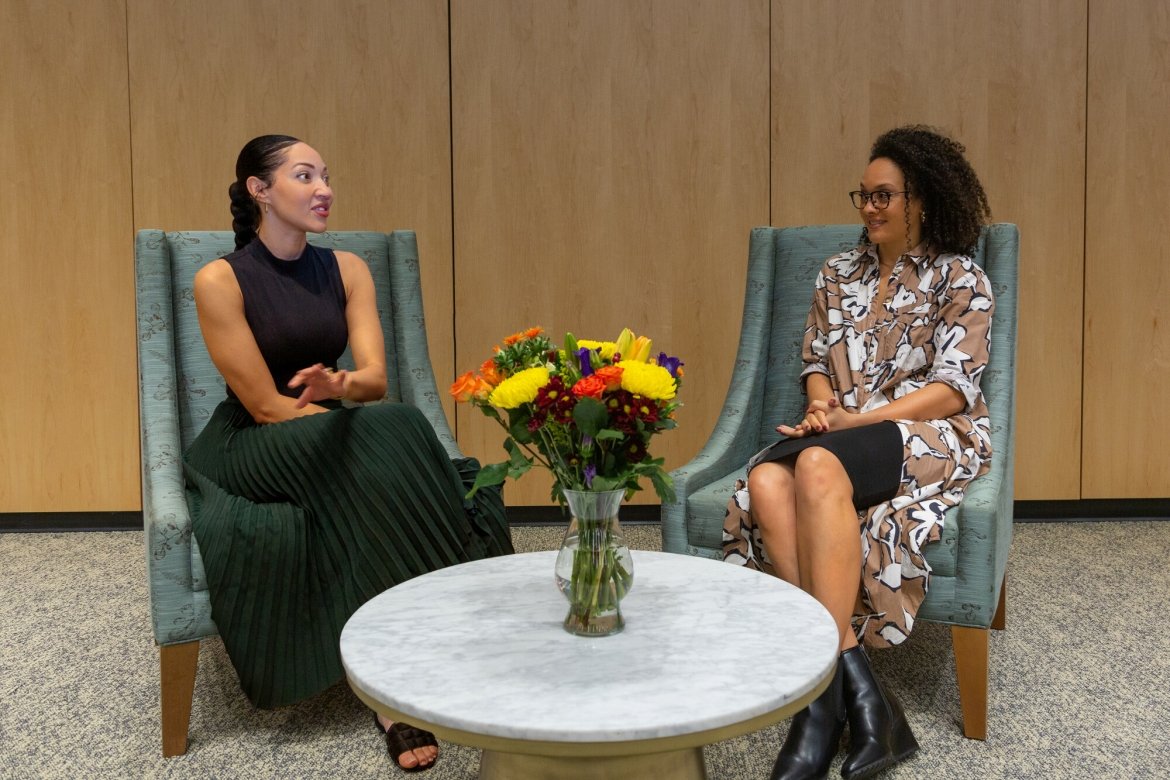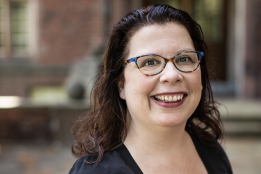Harmonia Rosales and “The Harvest”

Artist Harmonia Rosales spoke at the Mount Holyoke College Art Museum about her work, including her painting “The Harvest.”
On Sept. 19, at the Mount Holyoke College Art Museum (MHCAM), artist Harmonia Rosales discussed her artistic processes and her body of work, centering on her painting “The Harvest.” Rosales explored her creative background, her journey as a self-taught painter and her artistic epiphanies with Stephanie Sparling Williams.
Williams, the Andrew W. Mellon Curator of American Art at the Brooklyn Museum, is a former curator at MHCAM. She led the efforts to purchase “The Harvest” for the College’s museum. The purchase was Rosales’ first museum art sale.
Rosales is from an Afro-Cuban family but was primarily raised by the Cuban side of her family. As Rosales was growing up, her grandmother told her stories of the African gods. Rosales’ mother, a children’s book author and illustrator, took Rosales to the Art Institute of Chicago.
“I was particularly drawn to Renaissance works because they looked like children’s book illustrations,” Rosales said. “Large, detailed versions.” She endlessly entertained herself by retelling the stories embodied in the paintings.
The impetus for her artistic career came when Rosales took her then-5-year-old daughter to see the same paintings at the museum, expecting to spark similar joyous moments. However, her daughter wasn’t thrilled with the Renaissance works.
“‘Why aren’t you as happy as I am?’” Rosales asked her daughter. “She looked up at me, and she said, ‘She doesn’t look like me, Mommy.’”
That epiphany led Rosales to paint a world where her daughter’s beauty belonged, where Rosales herself felt like she belonged. “And by beginning to paint for a purpose, I began to find myself,” Rosales said.
Rosales is entirely self-taught. She didn’t major in art in college, she said, because she “didn’t like being told what to do.” She believes that “imperfections make the painting real.” She set about building a body of work that resonated with people of color and chose compositions that were familiar in order to create connections. She recontextualized the works to center women of color.
“The Harvest” reimagines French Baroque paintings. “The women are dominant; they feel powerful,” she said. “Here I saw a strong woman, Africa, surrounded by all the children of diaspora.”
Before her talk, Rosales met with a small group of students to discuss her work. Summer Pratt ’26, from Chicago, Illinois, was one of those students.
“I was so excited to meet her. I was also so nervous — I did not talk of my own will,” Pratt said. “My friends had to turn to me and ask, ‘Do you want to say something?’ And I was just thinking, ‘I’d like to so much, but I don’t think I can get it out.’”
Pratt, an anthropology major who is completing a Nexus in Museums, Archives and Public History, was able to explore more of the meaning in “The Harvest” when talking to Rosales.
“There [are] some things that I just completely did not pick up on,” Pratt said. “There is a child in the painting that has albinism. And when I look at the painting, that child’s looking directly at you, and it’s [holding] a broken string of pearls. So we were all asking, ‘This is about like the loss of innocence, right?’ And Rosales said, ‘I’m happy you picked that up. Did anyone else pick up about the genocide?’ And we [said], ‘Whoa! What genocide?’
“She [said] that even to this day, in certain parts of the continent of Africa, people with albinism are being persecuted and killed because, depending on the region, they can be seen as bad omens. So she chose to have the one [baby] with the broken string of pearls be a baby who had albinism because [with] that loss of innocence, of your life — and the moment you’re born being a crime immediately — you never had innocence.”
Thandiwe-Wanjiru Delgado-Kinyatti ’27, an English major from South Hadley, Massachusetts, was excited to talk to Rosales about “The Harvest,” as it was the first painting Delgado-Kinyatti saw in MHCAM that resonated with her.
“It reflected Black culture in the African diaspora,” Delgado-Kinyatti said. “I remember that it had been the only painting with Black people in it that I saw that day. So that’s why it caught my eye.
“You don’t often see yourself that much [in art],” she continued. “So you know, when you do see yourself, it stands out a lot. And then also, the painting itself is vibrant.”
This program was made possible by the Patricia and Edward Falkenberg Lecture Fund and is cosponsored with the departments of Art History, Art Studio and Religion, and the Office of Diversity, Equity, and Inclusion.
